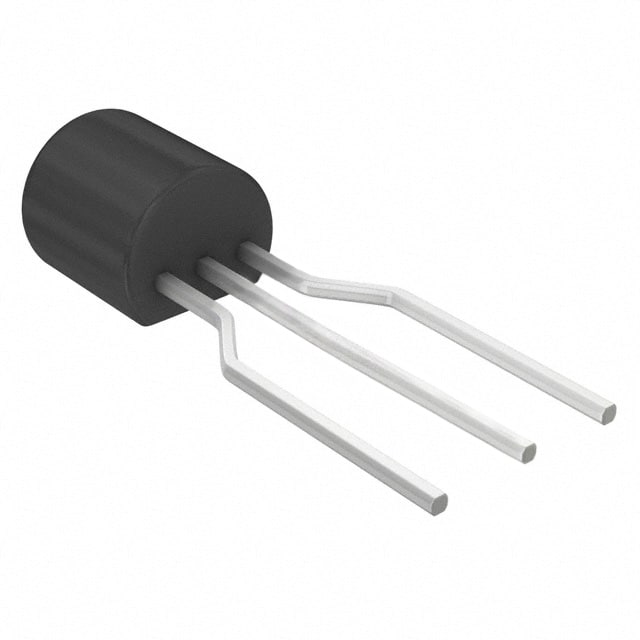Viz Specifikace pro podrobnosti o produktu.

BC548TFR - Transistor Encyclopedia Entry
Introduction
The BC548TFR is a type of transistor that belongs to the category of small signal NPN bipolar junction transistors. This entry provides an overview of the BC548TFR, including its basic information, specifications, pin configuration, functional features, advantages and disadvantages, working principles, application field plans, and alternative models.
Basic Information Overview
- Category: Small signal NPN bipolar junction transistor
- Use: Amplification and switching applications
- Characteristics: Low power, high voltage, and low frequency applications
- Package: TO-92 package
- Essence: Small signal amplification and switching
- Packaging/Quantity: Typically available in reels or tubes containing multiple units
Specifications
- Maximum Collector-Emitter Voltage (VCEO): 30V
- Maximum Collector-Base Voltage (VCBO): 30V
- Maximum Emitter-Base Voltage (VEBO): 5V
- Collector Current (IC): 100mA
- DC Current Gain (hFE): 110 - 800
- Power Dissipation (Ptot): 500mW
- Transition Frequency (ft): 150MHz
Detailed Pin Configuration
The BC548TFR transistor has three pins: 1. Emitter (E): Connected to the N-type material 2. Base (B): Controls the transistor action 3. Collector (C): Collects the majority charge carriers
Functional Features
- Small signal amplification
- Switching applications
- Low power consumption
- High voltage capability
- Low frequency operation
Advantages and Disadvantages
Advantages
- Suitable for low power applications
- High voltage tolerance
- Versatile for amplification and switching
- Low cost and widely available
Disadvantages
- Limited current handling capacity
- Relatively low transition frequency
- Not suitable for high power applications
Working Principles
The BC548TFR operates based on the principles of bipolar junction transistors. When a small current flows into the base terminal, it controls a larger current between the collector and emitter terminals. This allows for amplification and switching functions in electronic circuits.
Detailed Application Field Plans
The BC548TFR is commonly used in various low power electronic applications, including: - Audio amplifiers - Signal amplification circuits - Switching circuits - Oscillator circuits - Sensor interfaces
Detailed and Complete Alternative Models
Some alternative models to the BC548TFR include: - 2N3904 - BC547 - 2N2222 - 2N4401 - PN2222A
In summary, the BC548TFR is a small signal NPN bipolar junction transistor with applications in amplification and switching circuits. Its characteristics, specifications, pin configuration, functional features, advantages and disadvantages, working principles, application field plans, and alternative models make it a versatile component in the field of electronics.
[Word Count: 387]
Seznam 10 běžných otázek a odpovědí souvisejících s aplikací BC548TFR v technických řešeních
What is the BC548TFR transistor used for?
- The BC548TFR is a general-purpose NPN bipolar junction transistor commonly used in amplification and switching applications.
What are the typical operating conditions for the BC548TFR?
- The BC548TFR operates under a maximum collector current of 100mA, with a maximum collector-emitter voltage of 30V.
Can the BC548TFR be used for audio amplification?
- Yes, the BC548TFR can be used for small-signal audio amplification due to its low noise and high gain characteristics.
What are the pin configurations of the BC548TFR?
- The BC548TFR has three pins: the emitter (E), base (B), and collector (C).
Is the BC548TFR suitable for low-power switching applications?
- Yes, the BC548TFR is commonly used for low-power switching applications due to its fast switching speed and low saturation voltage.
What are some common alternatives to the BC548TFR?
- Common alternatives to the BC548TFR include the 2N3904, 2N2222, and PN2222 transistors.
What is the maximum power dissipation of the BC548TFR?
- The BC548TFR has a maximum power dissipation of 500mW.
Can the BC548TFR be used in high-frequency applications?
- While the BC548TFR can operate at moderate frequencies, it may not be suitable for high-frequency applications due to its transition frequency limitations.
Are there any specific considerations for soldering the BC548TFR?
- It is important to observe proper soldering techniques to prevent damage to the BC548TFR, such as using an appropriate soldering iron temperature and avoiding prolonged heat exposure.
Where can I find detailed specifications and application notes for the BC548TFR?
- Detailed specifications and application notes for the BC548TFR can be found in the manufacturer's datasheet and technical documentation.

